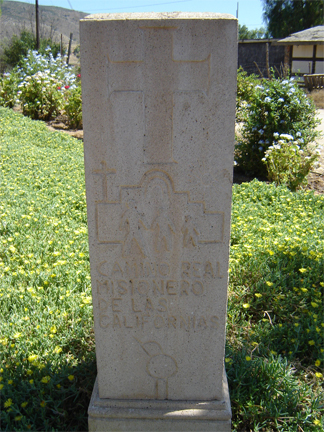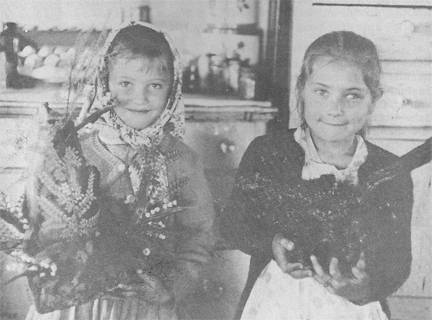 |  |
By David Kier

Spanish missionary Felix Caballero established California's last mission in 1834 as Nuestra Seúora de Guadalupe. Guadalupe was also the only mission to be established after 1821 when Mexico won its 11-year war of independence from Spain. In 1833, the new government in Mexico City had ordered all the Spanish missions secularized and their lands turned over to the locals, given away or sold. Because Baja California was so sparsely populated and remote, a special decree was made allowing the Dominicans to continue operating the missions on the peninsula. The decree did stipulate that once the mission padre had left or died he could not be replaced, allowing the mission system to eventually end on the peninsula. The Indian name for the area where the mission was built was 'Ojá cuúrr' meaning 'painted cave' for a nearby decorated granite rock with red, yellow and white pictographs.
The Guadalupe Valley proved to be very rich land and Caballero raised 4,915 head of cattle and many crops during the mission's short 6-year existence. Two miles of irrigation canals were built on both sides of the river valley and grapes, pears, apricots and grain was grown. The large  native population had originally embraced Padre Caballero, but turned against him after reported harsh treatment, forced baptisms and enslavement. The mission's Indians joined with other tribes who had been attacking the mission since 1836, and in February of 1840 their leader 'Jatúil' or 'Black Dog' frightened away Caballero who fled south to San Ignacio. Felix Caballero died the following year on July 11, 1840. The remaining peninsular Indians returned to their previous lives. Over the years most mixed with the mainland Mexicans who came to colonize Baja California, yet
some remained in their own communities. Those Indian villages exist today near Guadalupe and Santa Catarina, another mission location 50 miles southeast.
native population had originally embraced Padre Caballero, but turned against him after reported harsh treatment, forced baptisms and enslavement. The mission's Indians joined with other tribes who had been attacking the mission since 1836, and in February of 1840 their leader 'Jatúil' or 'Black Dog' frightened away Caballero who fled south to San Ignacio. Felix Caballero died the following year on July 11, 1840. The remaining peninsular Indians returned to their previous lives. Over the years most mixed with the mainland Mexicans who came to colonize Baja California, yet
some remained in their own communities. Those Indian villages exist today near Guadalupe and Santa Catarina, another mission location 50 miles southeast.
In 1863, the mission site was granted to Don José Matás Moreno, a former governor of Baja California. Moreno's daughters sold the land to the Russian colonist sect known as the Molokans who came to Baja California fleeing the czar's war with Japan. Governor Moreno was buried on the mission grounds and his family brought flowers to it for many years. The grave has vanished since then and a chain-link fence now surrounds the site, over-looking the river valley.
The new Russian (or 'Ruso') population built their town along a wide street lined with shade trees, Russian style homes, steam-bath houses and barns. Flocks of geese and beehives were introduced, as well. Men with long beards and women in long skirts were once the norm in Guadalupe. The cemetery has many unique grave markers for the Rusos that are very plain compared to the more elaborate ones used by the Mexicans.

Many of the Russians left in the 1920's but until just a few years ago you could still see blond and red haired descendents there. In the 1930's, Mexican farmers began to populate the valley and officially renamed the town Francisco Zarco.
Today you can visit the Nuestra Seúora de Guadalupe mission site in Francisco Zarco where they have ruins and a small museum with some great photos and historical artifacts that span the years from when the valley was first settled. The mission site is open from 8 a.m. to 5 p.m. from Wednesday to Sunday.
Just right down the street from the mission on Calle Principal (#276) the Russian descendants of the Samarin Family operate a Russian restaurant and museum. They are well known for their Russian bread ("pan Ruso"), marmalades, and wine. The restaurant serves traditional Russian dishes like borscht.
In addition, the Bibayoff family of Russian descent operate a winery and also have a museum dedicated to the Molokan settlement when their family first arrived in the valley. The winery and museum are open from 10 a.m. to 4 p.m. Tuesday through Sunday. Learn more about the Bibayoff winery.
To get to the Guadalupe Valley, take Mexico Highway 1 to the Highway 3 turnoff towards Tecate at El Sauzal (just north of Ensenada). The Guadalupe Valley is a quick 10 minute drive from the turnoff, and the mission site can be found in the center of the town of Francisco Zarco.